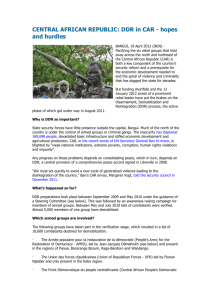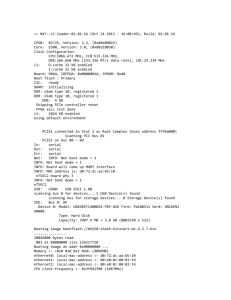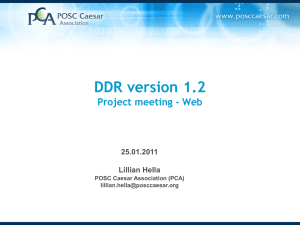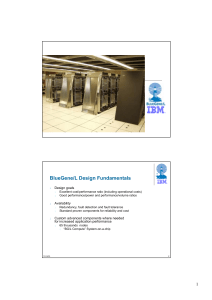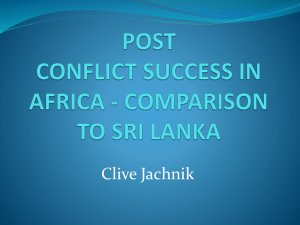Liberalism and Constructivism: Peace and DDR in the
advertisement
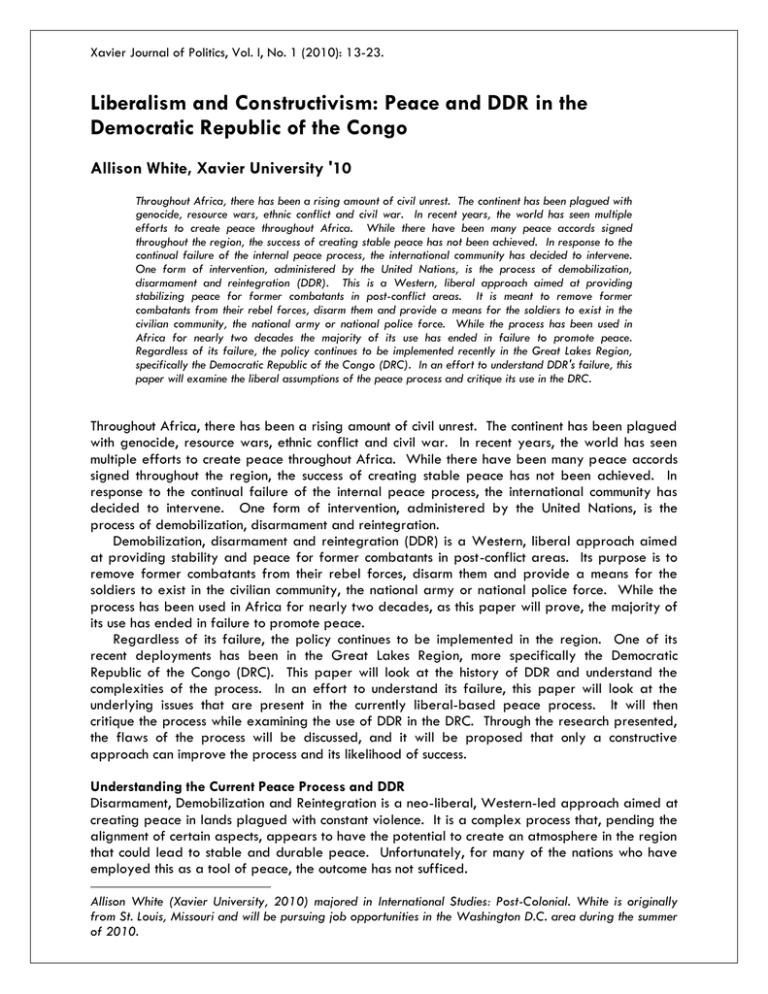
Xavier Journal of Politics, Vol. I, No. 1 (2010): 13-23. Liberalism and Constructivism: Peace and DDR in the Democratic Republic of the Congo* Allison White, Xavier University '10 Throughout Africa, there has been a rising amount of civil unrest. The continent has been plagued with genocide, resource wars, ethnic conflict and civil war. In recent years, the world has seen multiple efforts to create peace throughout Africa. While there have been many peace accords signed throughout the region, the success of creating stable peace has not been achieved. In response to the continual failure of the internal peace process, the international community has decided to intervene. One form of intervention, administered by the United Nations, is the process of demobilization, disarmament and reintegration (DDR). This is a Western, liberal approach aimed at providing stabilizing peace for former combatants in post-conflict areas. It is meant to remove former combatants from their rebel forces, disarm them and provide a means for the soldiers to exist in the civilian community, the national army or national police force. While the process has been used in Africa for nearly two decades the majority of its use has ended in failure to promote peace. Regardless of its failure, the policy continues to be implemented recently in the Great Lakes Region, specifically the Democratic Republic of the Congo (DRC). In an effort to understand DDR's failure, this paper will examine the liberal assumptions of the peace process and critique its use in the DRC. Throughout Africa, there has been a rising amount of civil unrest. The continent has been plagued with genocide, resource wars, ethnic conflict and civil war. In recent years, the world has seen multiple efforts to create peace throughout Africa. While there have been many peace accords signed throughout the region, the success of creating stable peace has not been achieved. In response to the continual failure of the internal peace process, the international community has decided to intervene. One form of intervention, administered by the United Nations, is the process of demobilization, disarmament and reintegration. Demobilization, disarmament and reintegration (DDR) is a Western, liberal approach aimed at providing stability and peace for former combatants in post-conflict areas. Its purpose is to remove former combatants from their rebel forces, disarm them and provide a means for the soldiers to exist in the civilian community, the national army or national police force. While the process has been used in Africa for nearly two decades, as this paper will prove, the majority of its use has ended in failure to promote peace. Regardless of its failure, the policy continues to be implemented in the region. One of its recent deployments has been in the Great Lakes Region, more specifically the Democratic Republic of the Congo (DRC). This paper will look at the history of DDR and understand the complexities of the process. In an effort to understand its failure, this paper will look at the underlying issues that are present in the currently liberal-based peace process. It will then critique the process while examining the use of DDR in the DRC. Through the research presented, the flaws of the process will be discussed, and it will be proposed that only a constructive approach can improve the process and its likelihood of success. Understanding the Current Peace Process and DDR Disarmament, Demobilization and Reintegration is a neo-liberal, Western-led approach aimed at creating peace in lands plagued with constant violence. It is a complex process that, pending the alignment of certain aspects, appears to have the potential to create an atmosphere in the region that could lead to stable and durable peace. Unfortunately, for many of the nations who have employed this as a tool of peace, the outcome has not sufficed. Allison White (Xavier University, 2010) majored in International Studies: Post-Colonial. White is originally from St. Louis, Missouri and will be pursuing job opportunities in the Washington D.C. area during the summer of 2010. XJOP, Vol. I., No. 1 (2010) Peace and DDR in the Congo Understanding the potential effects of DDR starts not at demobilization but at the initial steps of the peace process. Understanding these aspects should assist in understanding why the process continues to fail. As Mark Knight (2008) has theorized in his work „Expanding the DDR Model: Politics and Organizations,‟ both the peace process and DDR are reliant on one another. A sustainable recovery after war “cannot be achieved without a successful DDR process; yet, without a successful peace building process the viability of the DDR process would be questionable” (4). Therefore, this work must first look at the peace process before speaking on any policy that might result from it. The first stage of the peace process is dialogue. Peace talks bring warring parties together in an effort to create an atmosphere of peace. This atmosphere of peace is often represented by a cease-fire agreement and a commitment to have further peace talks. Ceasefires, by definition, declare an end to fighting. Unfortunately, in areas that have been plagued by war for many years, ceasefires do not have the power to terminate fighting. As Robert Muggah (2005) argues, “The UN, the World Bank and non-governmental organizations embody this „conventional interpretation‟ of post-conflict” (240). Muggah (2005) contends that international actors assume that “upon the signing of ceasefires, safety and security are likely to „return‟…collateral damage will decline…and development projects and investment can be hastily deployed” (240). International actors tend to plan and implement policy based on the assumption of conventional „post-conflict‟ over the reality that may actually be present in the war-torn nation. Muggah is not alone in noticing the misconception of the post-conflict strategy. As Paul Williams (2007) notes in his research of security in Africa, “security must make sense at the basic level of the individual human being for it to make sense at the international level” (1023). Due to the rapid deployment of post-conflict peace building operations, the international community is disconnected from the reality of the local environment. Signatures on paper do not always signal a readiness to stop fighting. Other scholars have added more peace process prerequisites that must be taken into account before post-conflict policy may be deployed (Lemarchard 2006; Mehler 2009; Williams 2007). Power sharing is often an aspect of peace processes that is too often not understood. As noted, warring sides are often brought into discussions of peace, and thus, the peace that results is one of compromise or power sharing, a liberal assumed ideal. Therefore, the reality of the process is that the contending sides will falsely position themselves to receive the best potential outcomes based on the compromising nature of the discussions. While the power sharing process has been used time and time again, the outcomes have no uniformly positive effects on peace or war and often ignore local security concerns (Mehler 2009). These local security concerns not only include manipulation by warlords to gain more power in a government that wants to see them banished but also leads to an “igni[tion of] insurgencies, thus resulting in „the reproduction of insurgent violence” (Lemarchand 2007, 13). Furthermore, power-sharing incentives tend to focus solely on former combatants and ensuring their security over that of the community. The incentive tends to leave communities out of the power-sharing agreements yet forces them to adhere to the peace provisions that often grant political power to rebels. Andreas Mehler (2009) contends that the power sharing agreement is not focused on the correct goal. The result is that power sharing inherently flaws the process because its focus is not on what peace is all about: security for the people. This error of power sharing, to include the community, leads us to an important concept of the peace process: inclusiveness. Inclusiveness is simply allowing all those in the society to participate. Rene Lemarchand (2007) states that “incorporation rather than exclusion” is seen as the key to conflict resolution (2). In those peace processes that have allowed exclusion to occur, failure is likely to result because exclusion creates new tension. This tension between the excluded and those who were included in the peace process generates „spoilers‟, occurrences that threaten the 14 XJOP, Vol. I., No. 1 (2010) Peace and DDR in the Congo peace process and often lead to its demise. The exclusion and ignorance presented to those not involved can often stimulate conditions of an even more violent insurgency or upraising (Lemarchand 2007, 17). Groups that are most often marginalized or excluded are women, children, civil society and local communities most impacted by war. Williams (2007) believes actors within civil society may hold the key to both rethinking and remaking security policies in Africa. The problem is that they are simply rarely asked for their input, which results in their continual marginalization within the process. The underlying issues of peace and peace building are clearly more complex than one could perceive at first glance. The issues discussed above are only the initial steps of the peace process. There are still many more factors that can be noted in the further steps of the peace process, such as selection of mediators, location of peace talks and so on. Regardless, with the underlying factors that have discussed in mind, it is now time to turn to the United Nations‟ popular „tool of peace‟ in post-conflict areas: DDR. As previously stated, DDR is a tool popularly used by the UN in stages of post-conflict development and peace-building. Unfortunately, in many cases DDR has resulted in failure. While nothing may come of this failed attempt of peace, the danger lies in what happens after the policy has failed. In instances noted by Gwinyayi Dzinesa (2007), unsuccessfully disarmed, demobilized and reintegrated former combatants pose significant threats to security and stability in many countries. For this reason, it is important to fully understand what DDR is and how it has attempted to bring peace to areas of war. DDR is a policy that provides direction in dealing with rebel troops in post conflict areas. To put the policy bluntly, “it is a combination of [the] integration [of rebel troops] into standing armies or police forces as well as civilian life” (Muggah 2005, 242). The first aspect, disarmament, is a mostly military operation concerned with the management of arms and ammunition in order to create secure and stable frameworks out of usually volatile immediate post conflict situations (Dzinesa 2007, 74). This often takes place in a centralized camp run by local police, local military or outside support. The second „D‟ in the process is demobilization. This is also a military based approach that aims to „demobilize‟ rebels from their units to decrease the amount of armed groups in the region. It dismantles troops and begins to provide a desire of civilian life. This process is often performed in congruence with disarmament in localized camps. In an effort to attract rebels to the idea of demobilization, many rebels are offered monetary compensation to encourage their transition to civilian life (Dzinesa 2007, 74). While monetary compensation may prove beneficial to the rebels, it plays a critical role in the relationships between civilians and former rebels. The last phase of the process is reintegration. This step is often the most important step of the process in terms of bringing peace to the area. The process is complex and long-term and is aimed at the actual resettlement of former combatants. It is multi-layered and tends to be less centralized (Dzinesa 2007, 74). Its aspirations include ex-combatant resettlement, an inclusion of communal decision making, an encouragement of sustainable civilian employment and assistance in adjusting attitudes, expectations and psychological trauma (Dzinesa 2007, 74). Unlike the two other steps, reintegration does not have a military aspect but instead focuses on life after war. In most cases, this process is fulfilled by a decentralized approach that takes months or years to fully implement, rather than at a camp. At first glance, DDR appears to have the potential to be very successful, at least based on its intentions to bring peace to the region. As Dzinesa (2007) explains, if this process is done correctly, it can “substantially reduce the chance of armed violence re-emerging and help the foundations for social and economic development take root” (74). However, from the multiple failings of many regions to fully transfer from areas of war to areas of peace, the promise of the process has become compromised. As the research will show, the failing of the policy is not found 15 XJOP, Vol. I., No. 1 (2010) Peace and DDR in the Congo in the process itself, yet is compromised by its liberal implementation that is controlled by the UN, a liberal minded international body. As we have discussed, disarmament is the first step of DDR. While the instructions are clear – remove weapons, create peace – the outcome has not been quite as promising. In past DDR attempts, disarmament was the first flawed step of the process that resulted in causing more harm to the surrounding community than good. In the case of Mozambique, while the weapon collection of the process went as planned, the second phase faced complications. The UN mission in Mozambique, UNOMOZ, collected thousands of weapons; however, the second step to destroy the weapons was never completed due to a new UN order to not ship the weapons to their proper areas for destruction. The lack of proper disposal led to the recirculation of a large proportion of the 190,000 weapons collected (Dzinesa 2007, 77). A similar situation occurred in Angola in the 1990s as crime increased exponentially during the process due to weapons reentering the market (Dzinesa 2007). Both failed attempts of DDR prove that without proper disarmament, the process will fail. Disarmament is also an important step to rebuild trust in the community. Through the transparency of the process, those in the affected communities can begin to see arms being given up by ex-combatants, and it can create an important step in reinstating trust. However, in the instances of Mozambique and Angola, the process was not only hampered, but the trust of the community continued to fall. In the cases of fairly successful disarmament, nations have been able to engage in the next step: demobilization. Much like disarmament, the process would appear to be simple – demobilize existing rebel units and begin to implement reintegration. Unfortunately, for many nations, this has not played out quite as easily. In the instance of Sierra Leone, the exclusion of child soldiers from the process posed a threat of violent insurgency in later years. As Allison Watson (2008) theorizes, the marginalization of “children in government policy in post conflict zones around the world results in inadequate care and in turn, an increased likelihood of social breakdown and possibly the resumption of conflict” (41). This was also the case in Uganda when child soldiers of the former Lord Resistance Army were not included in monthly consultations of the process. Dzinesa (2007) agrees that demobilization cannot exclude groups. Demobilization must account for specific provisions for the rehabilitation of the physically disabled and physically disturbed, as well as women and children. Other problems that demobilization has experienced include the sensitivity of time and the struggle to convince ex-combatants to leave their lives of rebel activity. Timing is important when it comes to demobilization. If it is taken on too quickly or too slowly, former combatants may be more likely to abandon the process due to the intensity or lack of notable progress. Timing must be appropriate to display control of the situation while addressing all underlying factions, such as trust and fear. Fear of the process lies both in the hands of combatants and the surrounding community. For the combatants, the fear arrives from no longer knowing their future in terms of economic stability. For the community, the fear arrives as ex-combatants are integrated into society (Faltas 2004; Furley 2006). The life of a rebel is often one of wealth and little regulation. Often rebel groups make a great deal of profit off land exploitation. Once this lifestyle is threatened, the process of reintegrating combatants into a life of normalcy becomes increasingly difficult. Through attempts to counteract the old lifestyle of rebels, many demobilization processes include a payment or some form of compensation to encourage their transition to civilian life (Dzinesa 2007, 74). While this compensation may attract ex-combatants to partake in DDR it also imposes several negative affects on the region. In the case of Liberia, the promise of monetary compensation led to rentseeking behavior and an increase of individuals claiming to be ex-combatants. This was not only an exploitation of the process, but in the case of Liberia, the influx of „rebels‟ strained the process and the funding of the project could not meet its needs (Spear 2006). Another problem with 16 XJOP, Vol. I., No. 1 (2010) Peace and DDR in the Congo monetary compensation is the resentment it may create in the surrounding communities whose destruction was plagued by these disbanding rebel groups. It will become important in the stage of reintegration to address this problem and offer a communal approach for cooperation. Reintegration, arguably the most complex stage of DDR, has many more stages that must be performed completely if DDR is to have any hope of success. The process not only has to establish a device to promote civilian life to combatants, but it must also be able to provide employment training, school enrollment, management of monitoring former rebels, provide health support, counseling and promote relations between communities and former rebels. It is a process that must be adequately funded and well organized. In reality, the opposite occurs (Dzinesa 2007; Faltas 2004; Furley 2006; Muggah 2005). Plagued by problems of power sharing and trust, communities that receive ex-combatants create a division between civilians and ex-combatants. To avoid this, it is important to take a community-based approach to implement the needs of both the former rebels and the community. One way reintegration can address this problem is by promoting employment of former rebels that will then help the local economy. Other ideas include the United Nations Development Program‟s response to this problem in the creation of a separate program called Community Action for Post-Conflict Recovery, which provides various forms of assistance to war-affected communities, such as projects to rehabilitate roads, schools, clinics and water pipes (Faltas 2004, 12). The positive spillover effects of this program, ranging from employment to reconciliation, have the potential to significantly assist the establishment of peace. Not only will the community be improving itself, it will also allow for combatants to develop vocational skills and prove their rehabilitation to their community. This community based approach for reintegration is critical for the promotion of civilian life. While the new UNDP program is important to the process, it alone cannot account for the responsibility of reintegration. Reintegration must also focus on the psychological aspects for former combatants. This should also be specialized in terms of men, women and children. Unfortunately, for this phase of DDR, funding is usually the weakness of the process. Reintegration is based on concepts that are abstract – psychology and security – which do not receive as much funding as those concepts of DDR that are more concrete – weapons reduction. In fact, “international donors are often less willing to fund [reintegration] and regard it as a responsibility of the state” (Furley 2006, 68). Reasons for this stance against funding reintegration are based on how the UN measures success. Unfortunately, the international community measures the success of DDR by the “collection of weapons rather than the extent to which DDR has demonstrably improved safety or security, much less human development or the Millennium Goals” (Muggah 2005, 246). Therefore, funding is ultimately the downfall of reintegration, as funds tend to run out before much policy can be implemented. Scholars and policy makers alike have been able to point to the problems that plague DDR from living up to its potential. While there should be some improvement towards the disabilities of the policy, this is sadly not occurring. In the case of South Africa, DDR has been poorly planed, badly executed and wholly inadequate in meetings the need of ex-combatants. It has failed to take into account many of the lessons learned from demobilization processes in other developing countries and in fact repeated some of the more obvious mistakes (Dzinesa 2007, 81). Therefore the question remains: why the UN is continuing to promote this policy? While certainly the odds are against this policy, the faults may not lie in the policy alone but in the actions taken by those who make it. Funding is obviously limited, but there are other problems that may have not been fully addressed in the process. As Watson (2008) notes, current peace-building operatives are based on „liberal‟ strategies – “the promotion of human rights, democratization, and human security” (35). While the rhetoric of the UN principles of peace-building seem ideal to promote peace with DDR, once these ideals are put into action the outcomes tend to lose the peace-promoting concepts, specifically those centered on humanitarian 17 XJOP, Vol. I., No. 1 (2010) Peace and DDR in the Congo issues, and instead “remain rooted in an institutional prescription” centered on power and compromise (Watson 2008, 35). Perhaps then it is important to understand both the policy and its actions and consider their repercussions on the surrounding community. From the research gathered and the analysis completed, the problem that hampers DDR is in its liberal implementation attempts. It assumes cooperation between perpetual enemies and believes cooperation can result in fairness. The reality is that this liberal approach impedes the DDR process from ever fully coming to fruition. Perhaps then DDR would be better served if it were taken as a constructivist approach – one based on cultural understanding of the local communities – and not on the Western image of liberal cooperative peace. This paper will attempt to test this constructive approach through examining the DRC and the implementation of DDR by the UN Mission to the Congo (MONUC) – doing so by comparing the actual occurrences of DDR against hypothesized approaches of a constructively based DDR. The theory presented here will not look at the concrete measurements of the policy, such as weapon reduction or unemployment rates, but will look at security and human rights and attempt to understand what the warring sides really want and if a commonality – a level of peace – can be found between them. The Democratic Republic of the Congo: A Case Study Today, the DRC is at war with itself, its citizens and its neighbors. After 10 consecutive years of conflict, the nation has lost nearly 3.3 million of its citizens to the consequence of war and has displaced thousands more (Rogier 2006). The destruction that lay in the wake of the Congolese War has been astonishing. While peace has not yet been established, it is certainly not due to the lack of trying. Throughout the course of the war, several peace talks have been held, ceasefires and memorandums have been signed and international dialogue has occurred. The result of these attempts has been far from successful. Certainly, some agreements have promoted periods of peace and others have been successful at reaching agreements of temporary democratization; however, the short-term peace in the DRC has not resulted in any hope of long-term stable peace. To understand the complexities of both the conflict and the attempts of peace, it is time to turn to the history of the war. In order to not get lost in the substantial history of the Congolese War, this paper will start at the DRC‟s process of peace beginning from the Sun City Inter-Congolese Dialogue that occurred in 2002, four years into the war. The Sun City dialogue resulted in a memorandum that implemented a power sharing government between warring groups. The „1 + 4‟ formula of state leadership consisted of an elected president and four vice presidents, each position representing a specific group of those involved in the conflict (Vlassenroot and Raeymaekers 2009). The elections occurred peacefully in 2006 and a leader, Joseph Kabila, was selected. Unfortunately, as is the nature of most power sharing situations, one individual felt ignored. JeanPierre Bembe, an opponent of Kabila, refused to recognize his own defeat. Due to this and a shared feeling from rebel leader Laurent Nkunda, the legitimacy of Kabila began to come under fire from many Congolese citizens. Soon, fighting broke out in the Kivu Province of the DRC led by Nkunda, his Congres National pour la defense du peuple (CNDP) armed group, and the rebel group Rassemblement Congolais pour la democratie (RCD) against the Congolese national forces, the Forces Armees de la Republique Democratique du Congo (FARDC). After several deadly conflicts, Kabila asked for the support of Rwanda in an attempt to stop Nkunda. In a vague peace agreement that was brokered between Nkunda and Kabila, the CNDP and the RCD agreed to disband and join the national army only on the compromising promise that the FARDC would attack the Forces Demcratiques de Liberation du Rwanda (FDLR), a Rwandan rebel group that had been operating in the DRC since 1994. 18 XJOP, Vol. I., No. 1 (2010) Peace and DDR in the Congo Kabila, without any other options, accepted and the FARDC attacked the FDLR. Not only was the attack a failure that displaced thousands of civilians, it also resulted in the disbandment of former RCD and CNDP troops from the FARDC. Furthermore, the attack lead to the proliferation of Hutu-rebel groups who supported the FDLR. Witnessing the utter destruction of the Kivu Province, the international community began again to press for peace talks. In 2007, the DRC responded with the „Conference on Peace, Security and Development in the Kivus‟ (Vlassenroot and Raeymaekers 2009). From this meeting – comprised of civil society members, members of 22 armed groups, representation from the government and international observers – came a series of peace agreements that would become known as the Amani Peace Process. The central aspects of the process were a ceasefire agreement between the FARDC and the FDLR and a commitment to respect of international humanitarian law, including acts of violence (DR Congo 2008). Unfortunately, like all of its predecessors, the Amani Peace Process has had little success as brutal conflict continues in the Kivu Province today (Eastern 2009). Despite its failure, the Amani Peace Process was unique in one specific area: inclusion. This ability to include all, even some armed groups who had not be active for years, was an attempt to create peace and avoid the threat of potential spoilers. Unfortunately, it may have led to the downfall of the process by creating a power-sharing situation between too many parties that resulted in groups falsely positioning themselves for ideal benefits from the peace process. As discussed, this tends to cause a problem later in the peace process. Despite its flaws the Amani Peace Process successfully displayed an important learning aspect for creating peace in areas of war. Nations with weak central power, a lack of security, and movements made by the government and armed groups that seem to be in the opposite direction of peace make power-sharing agreements even more unlikely to bring about peace, inclusion aside (Lemarchand 2007). Despite its overall failure to bring peace to the region, the Amani Peace Process did bring one tangible effect to the region: MONUC. MONUC, the UN Peace Keeping Mission in the Congo that has been present in the DRC since 2000, promised an augmentation of both financial support and personnel to the region when the process was signed. This promise symbolized an international commitment of peace-building efforts for the region. The history of MONUC in the region has been one of mediocrity. The mission began in 2000, in congruence with the Lakusa Accord (one of the first peace accords of the war that failed). In its early years, the mission was under funded and under staffed. Many of its tasks included attempting to implement mandates, protecting small groups of internally displaced persons and monitoring the 2006 elections (Adebajo 2006). Throughout the years, more and more MONUC personnel have been deployed to the DRC and more funding has been provided. The increased numbers and funding that accompanied the Amani Process has allowed the mission to focus on peace-building efforts and post-conflict development programs like DDR. DDR in the DRC has been a story of mixed success, confusion and fear. While the process was introduced to the region by MONUC, today there are several international actors that are deploying the process. Due to the wide array of actors in the region, there has been a problem of coordination and cooperation. Nicola Dahrendorf (2008) observes that demobilization of excombatants is marked by a patchwork of different initiatives leading to disjointed decisionmaking processes and little cooperation between actors, including the UN and other important bodies. This has resulted in missed deadlines of army integration, logistical problems between training programs and poorly organized and mismanaged training centers. Some centers were deemed unsuitable for human habitation and resulted in poor housing and a spread of disease (Dahrendorf 2008). To make matters worse, funding has been limited which further inhibits the development of proper centers for demobilization and disarmament. In some areas, there has been some success with the program, at least in the measurement of success accepted by the UN. In a study completed by Henri Boshoff with the Institute for Security 19 XJOP, Vol. I., No. 1 (2010) Peace and DDR in the Congo Studies (2008), as of mid-2008, approximately 186,468 combatants have taken to the program comprising 99,750 demobilized persons, including 30,219 children. So far, 15 new mixed Congolese brigades have been created and deployed in the field while another 80 thousand fighters remain to be disbanded. The large numbers of demobilized persons speak for themselves; however, it is important to keep in mind what comes next for these demobilized combatants. What the study does not discuss is how the combatants are taking to their new posts or civilian lives and why so many more combatants continue to be a threat to the community. This lack of information displays the misplaced importance of reintegration in many DDR operatives. As a result, a community that has a desire for peace and security has instead received a life of increased fear from all armed groups, rebel and government alike. From a Human Rights Watch report (2008) of DDR in the Congo, a great deal of humanitarian crime has been committed by the FARDC. Witness reports blame the FARDC for aimlessly killing and raping hundreds of civilians in the Kivu Province. As the report (2008) argues, the members of the FARDC are attacking the people they are meant to protect. From the divide in reports, it is apparent a problem exists in terms of the success of DDR in the DRC. Numerically, the program is going along fairly well – rebels are being demobilized and reintegrated into the local army. In terms of peace and security, the process, like many of its predecessors, has been an absolute failure as it has ignored the safety of civilians and has resulted in induced fear. Overall, when both success and failure are measured, it is clear that above all measurements peace has not been the result of the process. This paper predicts the reason for this failure is due to the ignorance that the liberal oriented process has towards the community of the DRC. From a liberal stance, culture and social identities do not matter. Fear is not seen as a real measurement in society; therefore, programs like DDR continue regardless of their social impacts. While DDR could be perceived as the sole instigator of accepting violence as a tool of power, the fault does not solely fall on the program. As presented in the previous section, the underlying prerequisites of the peace process play an important influential role in the process of peace, the same holds true in the DRC. The environment of the DRC during its attempts to create peace by use of DDR has certainly not excelled the likelihood of success for the program. The present situation of the DRC stems from many failed peace treaties that have displayed the faults of power sharing, the government and the international community. The failures have created a certain atmosphere that transposes itself on the culture and beliefs of the surrounding communities. A commonality of the attempted peace processes in the DRC is that attempts of peace result in the proliferation of rebel groups. Peace, that has been led by the pressures of the international community, may then be equated with an acceptance of violence. Therefore, the liberal peace process does not contain armed violence but actually amplifies it (Vlassenroot and Raeymakers 2009). Due to the mismanaged focus on institutions rather than the security of the people, violence has been accepted has the tool of the Congolese government and army (Vlassenrott and Raeymaekers 2009). Attitudes towards further peace processes and peace-building operatives may not be viewed as ideal for a community that is fearful of another failed process and its repercussions. In the small amount of DDR that has taken place in the DRC, the outcome has proven to be a fearful truth. As Koen Vlassenroot and Timothy Raeymaekers (2009) state, the premise of demobilization and integration (DDR) outlined by the Amani negotiation was used by armed forces to pump up its military ranks and reignite dormant armed factions. Therefore, the community views itself as under attack from both sides, government and rebel. Adding to the list of instigators of fear in the region, Patricia Daley (2006) and Filip Reyntjens (2007) state that due to the relationship between MONUC and the Congolese government, the people are also fearful of peacekeepers. Concluding the summary of the current DDR process in the DRC that is operating under a liberal 20 XJOP, Vol. I., No. 1 (2010) Peace and DDR in the Congo mind, it is evident that the process has been successful in creating and promoting one concept: fear. With fear being the result of the liberal approach to peace in the DRC, it is time to change the implementation of DDR. While there is no data to confirm or dismiss this theory, this paper will attempt to be clear in its argument. Constructivism attempts to understand the society in terms of culture and identity. In the case of the DRC, a constructive approach would attempt to understand the fear that has been placed on the society – the entire society of women, children and the civil society. If DDR and peace-building operatives were focused on understanding the community before attempting to implement policy, the outcome would be drastically different. The problems of peace building tend to be power sharing and exclusion. If the key concepts were not on how to get along with a division of power but instead focused on an understanding why groups do not get along, perhaps peace operatives would look at cultural identity between groups and societal acceptance or rejection of ideals instead. In the case of the DRC, in the Kivu region before an attempt of peace was made, fears and apprehensions were present in the community. Knowing no other way to gain the attention of the international community, these fears were demonstrated through violence. Unresolved issues of land access and citizenship were noticeable along with the confusion of ownership of mineral deposits (Vlassenroot and Raeymaekers 2009). Furthermore, the fear of marginalization and ethnic persecution ignited groups to arm themselves and see to it that they would not be left out of the benefits of peace (Vlassenroot and Raeymaekers 2008). Had these problems been identified by the government and international community the peace process would have occurred differently. The same argument can be made in the efforts of deploying DDR. Demobilized persons are rebelling because their concerns are not being addressed. The communities that are accepting demobilized persons are fearful and not allowing them to enter into their societies. Furthermore, the demobilized rebels who are integrated into the national army are acting as they did as rebels because the army lacks the understanding of the rebel culture. They are assigned to new brigades, yet they act the same because there was no attempt to understand their psychological makeup in regards to violence. In the DRC, DDR must then look at the culture of both rebels and communities and attempt to see how they can coexist. Currently, cultural identities are hampering the process because they have pushed aside and deemed unimportant. Today, it is time to listen to these identities and change the approach towards peace. As Karen Mingst (2004) states, it is important to know identities because identities can change the result of cooperative behavior and learning (75). From the damage that the liberal approach has caused for the community of the DRC, the only feasible way to fix it is by a constructive means. How then should the UN change their current use of DDR as a peace-building tool in areas of post-conflict? The answer is not easy and the process will not be short. DDR cannot be limited to a certain number of protocols. It cannot assume mutual cooperation, nor can it be implemented on a whim without proper study on the region. It must work with the community and not against it. It cannot look at simply the numbers of weapons and people that are being demobilized and disarmed. It needs to be able to adapt and work within a range of war torn areas that have more than one ethnic group. As constructivists would argue, the world is too complicated and there is no overarching theory in understanding international relations or people (Mingst 2004). Therefore, DDR cannot attempt to be a one-size fits all approach to peace. If history has taught us anything, it is that a liberal-lead DDR is currently not working. Conclusion The uniqueness that Africa holds in world politics is intriguing. An area that has the capability of being the richest and most prosperous continent in the world is constricted by war and turmoil between its own citizens. Its number of internal actors and ethnic groups create an atmosphere 21 XJOP, Vol. I., No. 1 (2010) Peace and DDR in the Congo that is not seen in many other parts of the world. The complexities of its conflicts create adversaries that seem nearly impossible to defeat. With much interest and hope, the international community has responded. The world‟s biggest players find themselves trapped in some of the most devastating conflicts of the region. The conflict of the DRC alone has taken the lives of millions and as the news reports, more are dying. In an effort to bring this devastation to an end, the international community has turned to DDR. While its hopes were high, the outcome has not been promising. It is time then for the UN to turn to itself and ask why. While some blame the financial strain for the failing efforts of DDR, the problem is more dynamic. The current peace operatives are rooted in a liberal understanding of the world. The process that assumes cooperation cannot work in areas with such a dynamic societal make-up. The identities of the community are being ignored and these shortcomings are being displayed in the failure of DDR. It is then time to look at a fresh approach. It is time to listen to the people in a constructive manner. The people of the DRC are fearful and only constructivism can understand and incorporate the needs of them. While this constructive approach is theoretical, it too has the possibility of coming under fire from intellectuals. The theory needs empirical evidence to strengthen its stance in the world, and fieldwork is needed. However, it should begin to be seriously considered by international players as they make polices that effect post-conflict communities around the world. The DRC deserves to find peace. As long as the international community continues to become involved, their approach needs to change. Communities need to be seen as important. Cultural identities need to be considered while creating peace. The UN needs both mandates and actions to promote peace that have the capability of providing security for its citizens. With mistakes resulting in deaths, it is clearly time to change and it must occur now. References Adebajo, Adekeye. 2006. “The United Nations.” In Security Dynamics in Africa’s Great Lakes Region, ed. Gilbert M. Khadiagala. Boulder: Lynne Rienner, 141-161. Boshoff, Henri. 2008. “Security Sector Reform in the Democratic Republic of the Congo: The Status of Military Reform.” African Security Review 17 (June): 62-65. Daley, Patricia. 2006. “Challenges to Peace: Conflict Resolution in the Great Lakes Region of Africa.” Third World Quarterly 27 (2): 303-319. Dahrendorf, Nicola. 2008. “MONUC and the Relevance of Coherent Mandates: The Case of the DRC.” In Security Sector Reform and UN Integrated Missions: Experience from Burundi, the Democratic Republic of Congo, Haiti, and Kosovo, ed. Heiner Hänggi and Vincenza Scherrer. Berlin: Verlag, 67-112. Dzinesa, Gwinyayi A. 2007. “Post conflict Disarmament, Demobilization, and Reintegration of Former Combatants in Southern Africa.” International Studies Perspectives 8 (1): 73-89. Faltas, Sami. 2005. “DDR Without Camps.” In Conversion Survey: Global Disarmament, Demilitarization, and Demobilization, ed. Bonn International Center for Conversion. Germany: Nomos Verlagsgesellschaft Baden-Baden, 1-15. Human Rights Watch. 2008. “DR Congo: Peace Process Fragile, Civilians at Risk: More Than 200 Killed and 150,000 Displaced Since January Accord Signed,” Human Rights Watch (July 27). 22 XJOP, Vol. I., No. 1 (2010) Peace and DDR in the Congo Human Rights Watch. 2009. “Eastern DR Congo: Surge in Army Atrocities: UN Peacekeeping Force Knowingly Supports Abusive Military Operatives,” Human Rights Watch (November 2). Knight, Mark. 2008. “Expanding the DDR Model: Politics and Organizations.” Journal of Security Sector Management 6 (1): 1-18. Lemarchand, Rene. 2007. “Consociationalism and Power Sharing in Africa: Rwanda, Burundi, and the Democratic Republic of the Congo.” African Affairs 106 (422): 1-20. Mehler, Andreas. 2009. “Peace and Power Sharing in Africa: A Not So Obvious Relationship.” African Affairs 108 (432): 453-473. Mingst, Karen A. 2004. “Contending Perspectives: How to Think About International Relations Theoretically.” In Essentials of International Relations. New York: W.W. Norton and Company, 55-82. Muggah, Robert. 2005. “No Magic Bullet: A critical Perspective on Disarmament, Demobilization and Reintegration (DDR) and Weapons Reduction in Post-conflict Contexts.” The Round Table 94 (379): 239-252. Reyntjens, Filip. 2007. “Briefing: Democratic Republic of Congo: Political Transition and Beyond.” African Affairs 106 (423): 307-317. Rogier, Emeric. 2006. “Democratic Republic of the Congo: Problems of the Peacekeeping Process.” In Ending Africa’s Wars: Progressing to Peace, ed. Oliver Furley and Roy May. Hampshire: Ashgate, 99-114. Spear, Joanna. 2006. “Disarmament, Demobilization, Reinsertion and Reintegration in Africa.” In Ending Africa’s Wars: Progressing to Peace, ed. Oliver Furley and Roy May. Hampshire: Ashgate, 63-80. Vlassenroot, Koen and Timothy Raeymaekers. 2009. “Briefing: Kivu‟s Intractable Security Conundrum.” African Affairs 108 (432):475-484. Watson, Allison. 2008. “Can There Be a “Kindered” Peace?” Ethics and International Affairs 22.1 (Spring): 35- 42. Williams, Paul D. 2007. “Thinking About Security in Africa.” International Affairs 83 (6): 1021-1038. 23

